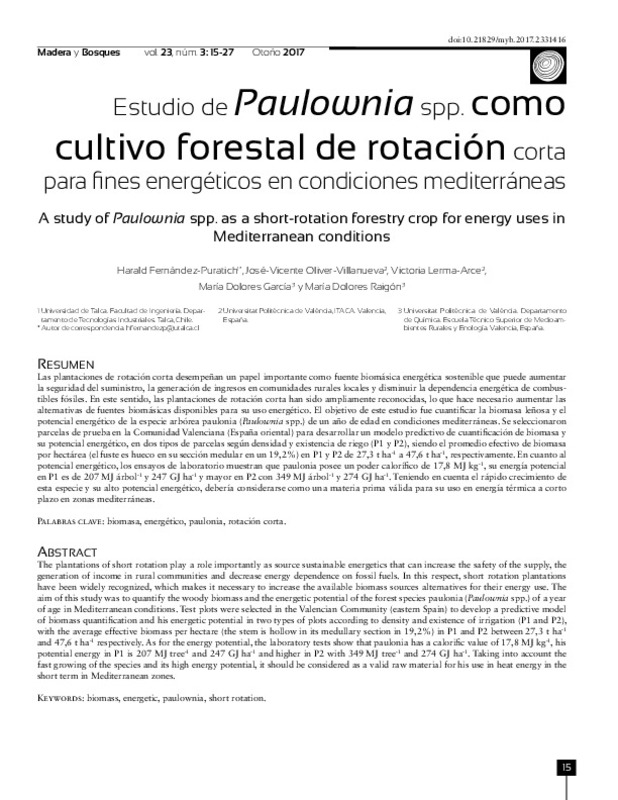JavaScript is disabled for your browser. Some features of this site may not work without it.
Buscar en RiuNet
Listar
Mi cuenta
Estadísticas
Ayuda RiuNet
Admin. UPV
Estudio de Paulownia spp. como cultivo forestal de rotación corta para fines energéticos en condiciones mediterráneas
Mostrar el registro sencillo del ítem
Ficheros en el ítem
| dc.contributor.author | Fernández-Puratich, Harald Wilson
|
es_ES |
| dc.contributor.author | Oliver Villanueva, José Vicente
|
es_ES |
| dc.contributor.author | Lerma Arce, Victoria
|
es_ES |
| dc.contributor.author | María Dolores García
|
es_ES |
| dc.contributor.author | Raigón Jiménez, Mª Dolores
|
es_ES |
| dc.date.accessioned | 2018-06-08T04:27:28Z | |
| dc.date.available | 2018-06-08T04:27:28Z | |
| dc.date.issued | 2017 | es_ES |
| dc.identifier.issn | 1405-0471 | es_ES |
| dc.identifier.uri | http://hdl.handle.net/10251/103620 | |
| dc.description.abstract | [EN] The plantations of short rotation play a role importantly as source sustainable energetics that can increase the safety of the supply, the generation of income in rural communities and decrease energy dependence on fossil fuels. In this respect, short rotation plantations have been widely recognized, which makes it necessary to increase the available biomass sources alternatives for their energy use. The aim of this study was to quantify the woody biomass and the energetic potential of the forest species paulonia (Paulownia spp.) of a year of age in Mediterranean conditions. Test plots were selected in the Valencian Community (eastern Spain) to develop a predictive model of biomass quantification and his energetic potential in two types of plots according to density and existence of irrigation (P1 and P2), with the average effective biomass per hectare (the stem is hollow in its medullary section in 19,2%) in P1 and P2 between 27,3 t ha-1 and 47,6 t ha-1 respectively. As for the energy potential, the laboratory tests show that paulonia has a calorific value of 17,8 MJ kg-1, his potential energy in P1 is 207 MJ tree-1 and 247 GJ ha-1 and higher in P2 with 349 MJ tree-1 and 274 GJ ha-1. Taking into account the fast growing of the species and its high energy potential, it should be considered as a valid raw material for his use in heat energy in the short term in Mediterranean zones. | es_ES |
| dc.description.abstract | [ES] Las plantaciones de rotación corta desempeñan un papel importante como fuente biomásica energética sostenible que puede aumentar la seguridad del suministro, la generación de ingresos en comunidades rurales locales y disminuir la dependencia energética de combustibles fósiles. En este sentido, las plantaciones de rotación corta han sido ampliamente reconocidas, lo que hace necesario aumentar las alternativas de fuentes biomásicas disponibles para su uso energético. Es así como este estudio trata sobre cuantificar la biomasa leñosa y el potencial energético de la especie arbórea paulonia (Paulownia spp.) de un año de edad en condiciones mediterráneas. Para ello, se seleccionaron parcelas de prueba en la Comunidad Valenciana (España oriental) para desarrollar un modelo predictivo de cuantificación de biomasa y su potencial energético, en dos tipos de parcelas según densidad y existencia de riego (P1 y P2), siendo el promedio efectivo de biomasa por hectárea (el fuste es hueco en su sección medular en un 19,2%) en P1 y P2 de 13,9 a 15,3 t ha-1 respectivamente. En cuanto al potencial energético, sabiendo que los ensayos de laboratorio muestran que paulonia posee un poder calorífico de 17,8 MJ kg-1, su energía potencial en P1 es de 207 MJ árbol-1 y 247 GJ ha-1 y mayor en P2 con 349 MJ árbol-1 y 274 GJ ha-1. Es por esto que teniendo en cuenta el rápido crecimiento de esta especie y su alto potencial energético, debería ser considerada como una materia prima válida para su uso en energía térmica a corto plazo en zonas mediterráneas. | es_ES |
| dc.language | Español | es_ES |
| dc.publisher | Instituto de Ecologia, A.C. | es_ES |
| dc.relation.ispartof | Madera y Bosques | es_ES |
| dc.rights | Reconocimiento - No comercial - Compartir igual (by-nc-sa) | es_ES |
| dc.subject | Paulonia | es_ES |
| dc.subject | Rotación corta | es_ES |
| dc.subject | Biomasa | es_ES |
| dc.subject | Energético | es_ES |
| dc.subject | Biomass | es_ES |
| dc.subject | Energetic | es_ES |
| dc.subject | Paulownia | es_ES |
| dc.subject | Short rotation | es_ES |
| dc.subject.classification | EDAFOLOGIA Y QUIMICA AGRICOLA | es_ES |
| dc.subject.classification | INGENIERIA AGROFORESTAL | es_ES |
| dc.subject.classification | QUIMICA ANALITICA | es_ES |
| dc.title | Estudio de Paulownia spp. como cultivo forestal de rotación corta para fines energéticos en condiciones mediterráneas | es_ES |
| dc.title.alternative | A study of Paulownia spp. as a short-rotation forestry crop for energy uses in Mediterranean conditions | es_ES |
| dc.type | Artículo | es_ES |
| dc.identifier.doi | 10.21829/myb.2017.2331416 | es_ES |
| dc.rights.accessRights | Abierto | es_ES |
| dc.contributor.affiliation | Universitat Politècnica de València. Departamento de Ingeniería Rural y Agroalimentaria - Departament d'Enginyeria Rural i Agroalimentària | es_ES |
| dc.contributor.affiliation | Universitat Politècnica de València. Departamento de Química - Departament de Química | es_ES |
| dc.description.bibliographicCitation | Fernández-Puratich, HW.; Oliver Villanueva, JV.; Lerma Arce, V.; María Dolores García; Raigón Jiménez, MD. (2017). Estudio de Paulownia spp. como cultivo forestal de rotación corta para fines energéticos en condiciones mediterráneas. Madera y Bosques. 23(3):15-27. doi:10.21829/myb.2017.2331416 | es_ES |
| dc.description.accrualMethod | S | es_ES |
| dc.relation.publisherversion | https://doi.org/10.21829/myb.2017.2331416 | es_ES |
| dc.description.upvformatpinicio | 15 | es_ES |
| dc.description.upvformatpfin | 27 | es_ES |
| dc.type.version | info:eu-repo/semantics/publishedVersion | es_ES |
| dc.description.volume | 23 | es_ES |
| dc.description.issue | 3 | es_ES |
| dc.relation.pasarela | S\343252 | es_ES |








